Pro-Kremlin outlets and Telegram channels use transcription glitch to discredit Zelensky
Multiple outlets promoted an automated captioning error by C-SPAN to embarrass the Ukrainian president
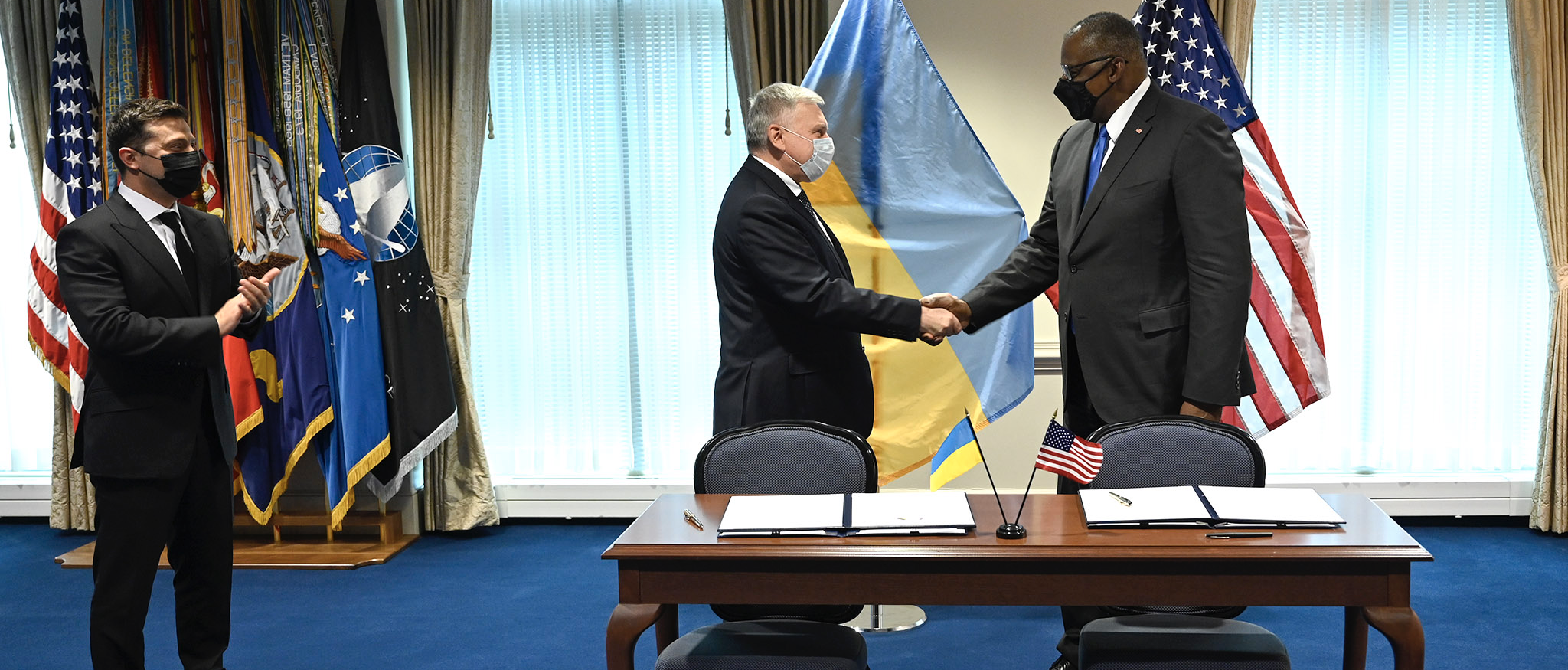
BANNER: US Defense Secretary Lloyd Austin shakes hands with Ukrainian Defense Minister Andriy Taran as President Volodymyr Zelensky stands to the side. (Source: @ZelenskyyUA/archive)
Multiple Kremlin-aligned media and Telegram channels amplified a typo in the closed captions of a September 2021 C-SPAN broadcast, pointing to a mistake in the transcription of Ukrainian President Volodymyr Zelensky’s name as representative of the US media and the Biden administration’s supposed disrespect for him.
The Kremlin — and its aligned media ecosystem — sees opportunity in instilling doubt in the US-Ukraine relationship, as the latter relies on the support of the US in countering Russian provocations and aggression within its borders. On September 1, 2021, Zelensky — while on a diplomatic visit to the United States — met with US Secretary of Defense Lloyd Austin, which was covered by C-SPAN, a nonprofit news channel devoted to covering public events around the US federal government. During the meeting, the channel’s automated closed captioning system accidentally mistranslated “Zelensky” as “Lewinsky” in one instance. Pro-Kremlin media outlets presented the error as an intentional attack on the Ukrainian president by using it as shorthand for a lack of respect given its association with Monica Lewinsky. In the late 1990s, Lewinsky was central to the impeachment inquiry of then-US President Bill Clinton, for which she was unfairly stigmatized and bullied across mainstream media.)
Mainstream Russian media outlets reported on the incident, then analyzed how fringe outlets and commenters aligned with the Kremlin took the opportunity to “demonstrate Ukraine its place” and use it to prove that the Ukrainian president’s visit to the United States was insignificant. This latest incident, however, was not the first time Kremlin-aligned sources — as well as Zelensky’s opponents in Ukraine — have mocked him by referring to him as “Lewinsky” while he courted a deeper relationship with the United States. A similar episode took place during his visit with President Trump in 2019, when Quartz wrote about how Zelensky had acquired his nickname in Ukraine given his connection to Trump’s first impeachment.
Kremlin-aligned outlets similarly covered the Ukrainian president’s recent US visit, which they claimed to be unsuccessful and portrayed Zelensky as a “beggar.” Numerous outlets and Telegram channels used the C-SPAN’s automated caption error to imply that the United States supposedly has a contemptuous attitude toward Ukraine, despite the significant agreements that came out of the visit.
C-SPAN and “President Lewinsky”
Sufficient time has passed since the original circumstances that brought Monica Lewinsky international scrutiny, such that there are growing calls for the US media to issue an apology to her. At the time, much of the framing around the events of the 1998 impeachment laid much of the blame at Lewinsky’s feet in a hyper-sexualized, bullying way. American media and popular culture has since started to reckon with how it portrays women, with Lewinsky as a significant example — though she is still used as a punchline for some US late night comedians. That same reckoning, however, has not gone fully global, as Lewinsky’s name remains the subject of disrespectful jokes and political point-scoring.
The transcription error appeared during the Ukrainian president’s meeting with Defense Secretary Austin at the Pentagon on September 1. The mistake occurred at the opening of the secretary’s speech, when he welcomed Zelensky and Ukrainian Defense Minister Andriy Taran, pronouncing both of their names correctly, as evident in the video. C-SPAN automated transcript, though, captured both of their names as “Lewinsky” and “Tehran,” respectively.
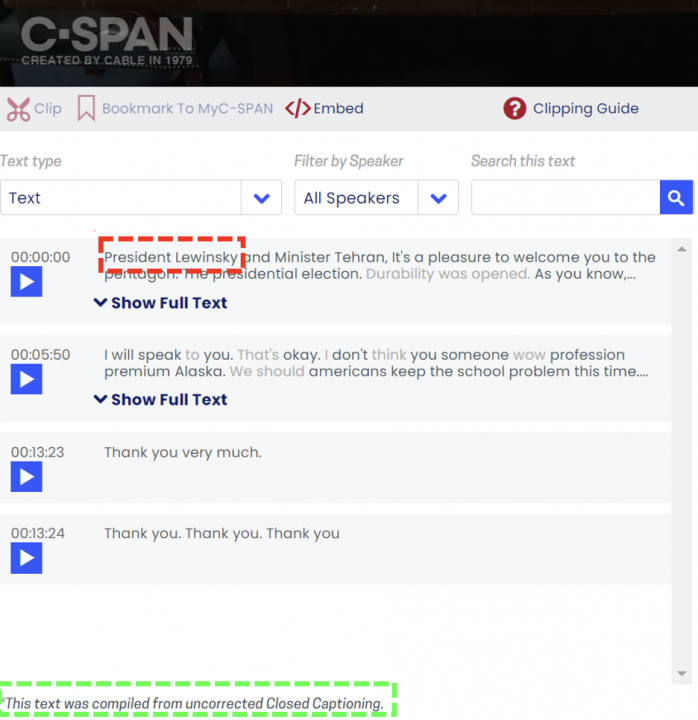
As the event continued, Defense Minister Taran’s name was mistranscribed multiple times, with the captioning software transcribing him as “Tehran,” “Theron,” and “Toronto” interchangeably. It also accidentally captured the Ukrainian translator’s speech, attempting to transcribe it into English.
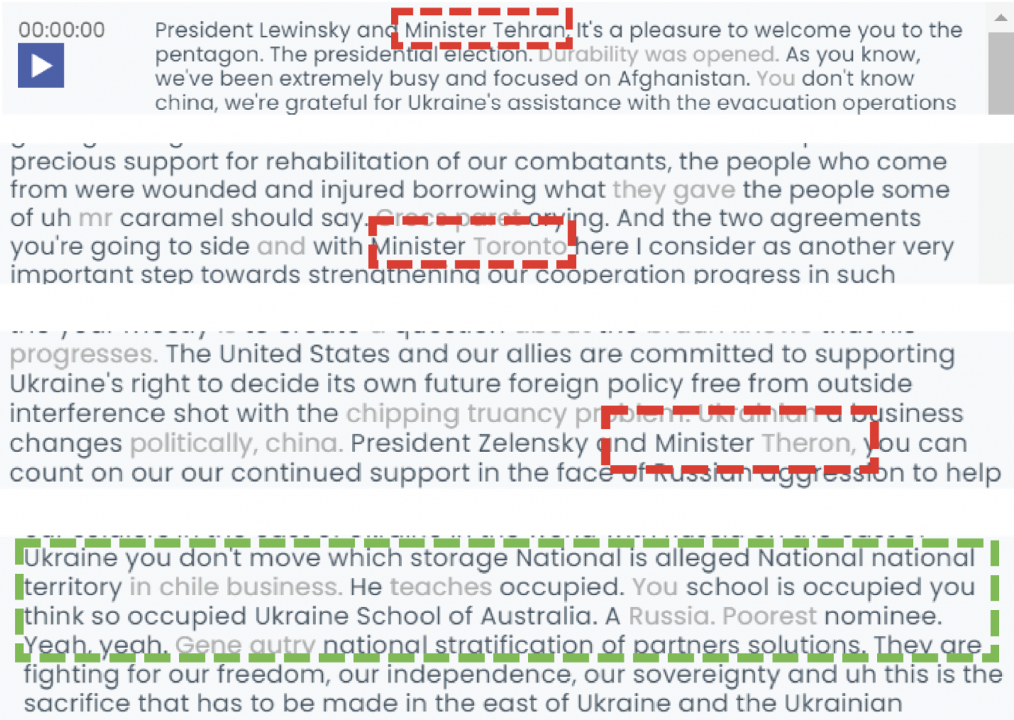
Weaponizing the error
Kremlin-owned RIA News, Russia 1, and Sputnik all covered the mistake and used the opportunity to attack Zelensky, essentially making noise out of an otherwise banal technical error.
RIA News acknowledged that the incorrect last name only appeared in the meeting transcript only at the start of the meeting, and provided some background on Monika Lewinsky and the Clinton scandal. Russia 1, meanwhile, started its video report on the meeting by mentioning the mistake, saying “President Zelensky, or Lewinsky, as he was called on US television.” Additionally, the TV anchor emphasized that the Ukrainian presidential visit was not a top priority for US officials, stating “Kyiv begged Washington to meet before the Biden-Putin negotiations, but the US rescheduled Zelensky’s visit multiple times.”
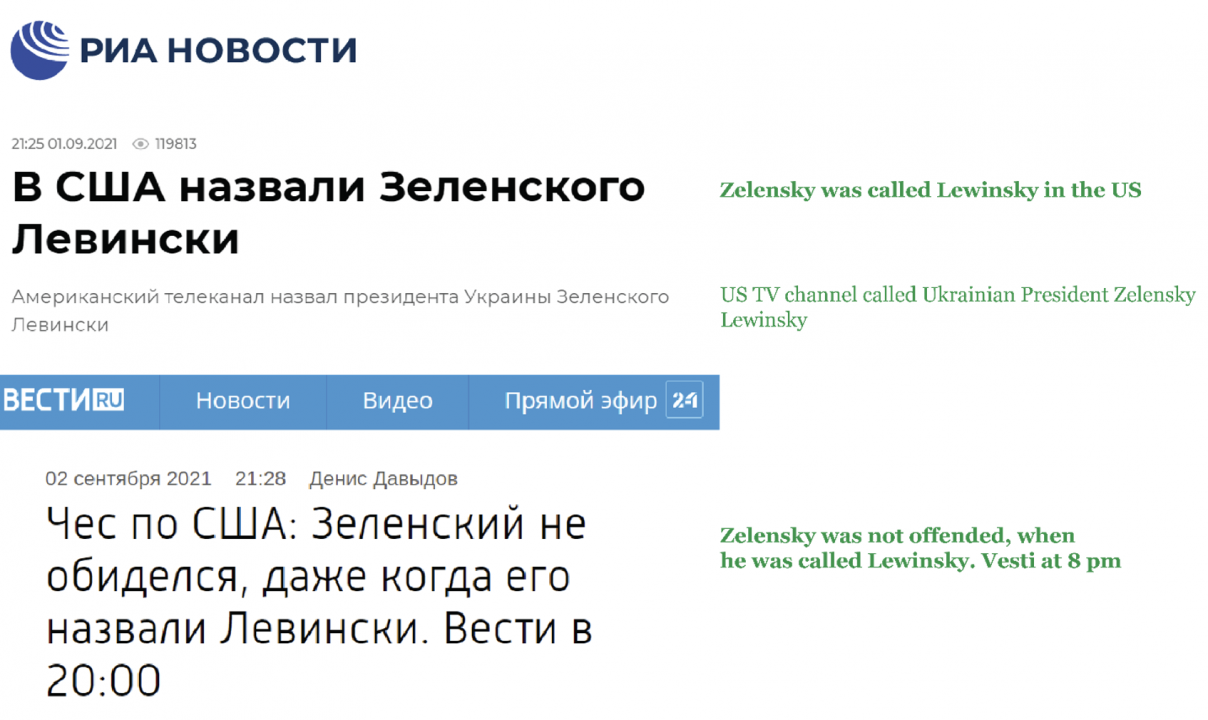
Sputnik published an interview with pro-Russian blogger Anatoliy Shariy, who was recently sanctioned by the National Security and Defense Council of Ukraine for spreading pro-Russian propaganda. In the interview, the blogger claimed “Zelensky was called ‘Lewinsky’ in the US press” without any context or sourcing.
Московский Комсомолец (Moscow Komsomolets), meanwhile, claimed the “TV channel’s staff made a mistake” and mixed up the two last names. Lenta cited the RIA News report with the same description of the Lewinsky scandal and mentioned comedian Jimmy Kimmel’s joke on Zelensky being President Trump’s “Lewinsky.” Tsargrad went further and included expert commentary on the US-Ukrainian relationship, presenting Zelensky as a servile figure. Multiple media outlets like IZ.ru, BB.lv, and PolitExpert mentioned the story as well, but pointing only to the mistake and explaining who Monica Lewinsky is. The only media outlet that acknowledged that the captions could have been a technical error was Gazeta.ru, which stated it “might have been created without human input.”
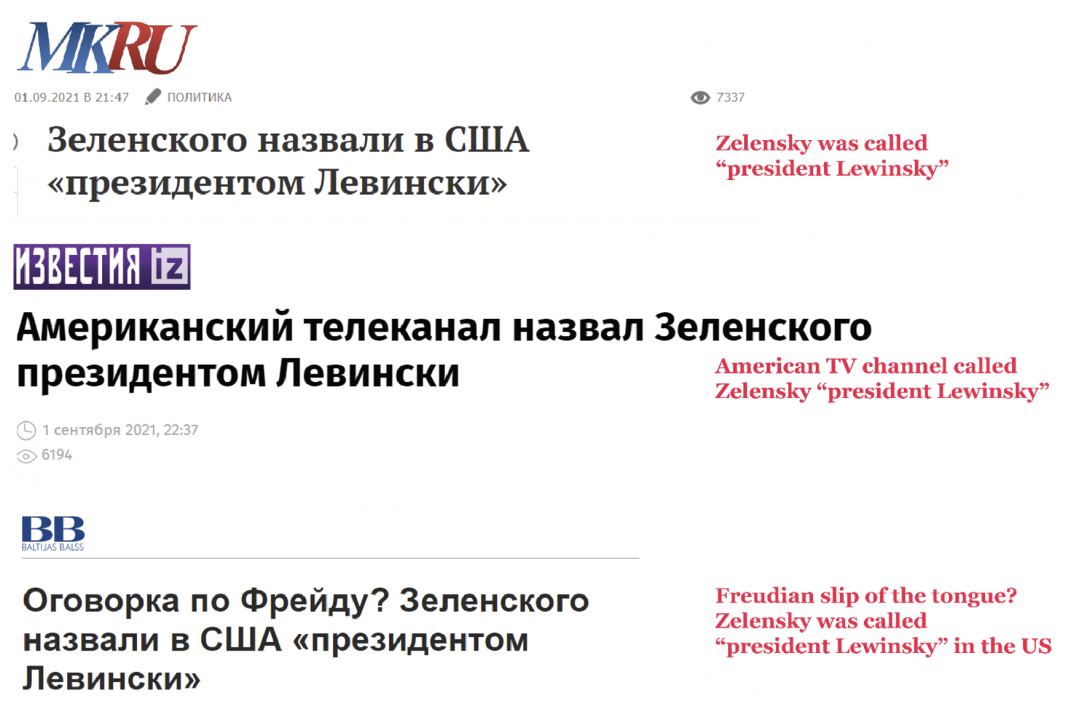
While most media outlets focused primarily on the snafu itself, pro-Kremlin Telegram channels did not restrain themselves. For instance, the channel Минправды (“Ministry of Truth”), which describes itself as “Checking the facts. #factchecking,” claimed that the Ukrainian president’s trip “was not positive for his image,” because he was referred to as “President Lewinsky.” While the channel acknowledged that it had been a mistake, it added a video clip that failed to explain what happened and reiterated the misleading coverage from other outlets. The post received 19,200 views.
Among the most widely seen posts on Telegram was a post to the channel Армагеддоныч (“Armageddon Man”), which is supposedly maintained by Evgeny Satanovsky, director of the Institute for the Middle East, a Russian think tank. While the Institute claims that it does not comment on post-Soviet issues apart from ones connected with the Middle East, Satanovsky is a regular talking head in propagandistic TV shows like “Solovyov Live.” While commenting on Zelensky’s visit to the United States, the Telegram channel claimed the US media had called Zelensky “President Lewinsky” after he “annoyingly pestered and harassed Biden in every possible way.” The post was seen 58,800 times and received a significant boost from it was forwarded by the host of “Solvyov Live” on his own channel, receiving an additional 42,800 views.
On Twitter, the transcription error was mentioned in tweets that either criticized the results of the meeting or mocked Zelensky and Ukraine regarding their role in the world arena. These tweets, however, were not particularly widespread. According to a query using social media listening tool Meltwater Explore, the terms “President Lewinsky” or “Monica Zelinsky” (a nickname used to mock Zelensky during the 2019 impeachment scandal) appeared on Twitter 192 times during the first week of September, immediately following his visit.

Ultimately, this case demonstrates how Kremlin-aligned outlets embrace insignificant incidents like a simple transcription error to denigrate political opponents. Kremlin-owned and Kremlin-aligned media used an outdated, sexist bullying attack to mock Zelensky and his meetings with US officials. While the episode received limited engagement on Twitter, it met with some success on media outlets and Telegram, where “political experts” exaggerated the incident to downplay the presidential trip and instill doubt in Zelensky’s leadership abilities.
Cite this case study:
Roman Osadchuk, “Pro-Kremlin outlets and Telegram channels use transcription glitch to discredit Zelensky,” Digital Forensic Research Lab (DFRLab), October 4, 2021, https://medium.com/dfrlab/pro-kremlin-outlets-and-telegram-channels-use-transcription-glitch-to-discredit-zelensky-cdb4e96be550.

